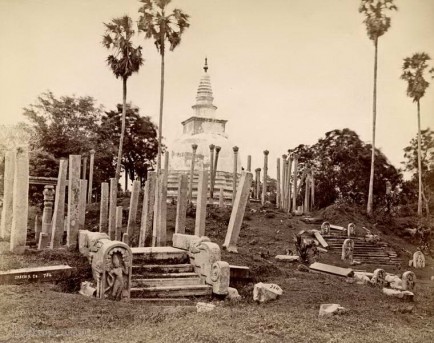
The Thuparama Temple in the background, in the foreground are the remains of the Dalada Maligawa, where was enshrined the tooth of Buddha.
After Arahat Mahinda introduced Buddhism during the reign of King Devanampiya Tissa (307-267 BC), in the Sri Lanka’s ancient sacred capital, Anuradhapura, the king built the Maha Vihara, a temple and residence for the monks, after dedicating the Nandana and Mahamega royal pleasure gardens to the Maha Sangha.
The earliest monument found in Sri Lanka is the ‘Stupa,’ which is described as a hemispherical dome surmounted with a spire (‘kota’). During the time of Emperor Asoka, numerous ‘stupas’ were built at hallowed sites in India. In these were enshrined relics of the Buddha which people venerated. When it was observed that there were no Buddha relics in Sri Lanka, the king, on Arahat Mahinda’s suggestion, appealed to Emperor Asoka to send some relics. He responded to the king’s request and sent the right collarbone relic of the Buddha.
In the middle of the dagaba was built a relic chamber, in the centre of which was placed a bo-tree made of precious metals, and an image of the Buddha round which were groups of figures representing various events in the life of the Buddha.
King Devanam Piya Tissa built the Thuparama dagaba to enshrine this relic. This was thus the oldest stupa built in Sri Lanka. Originally it was in the shape of a heap of paddy but as restorations were done in later years, it took the form as seen today. It has a diameter of 59 feet 6 inches (18.14 m) at the base. As the name suggests, Thuparama comprised a ‘stupa’ and an ‘arama,’ a residential complex. Ruins of such a complex can be seen within an area of over 3 acres (12,000 m2) around the ‘stupa.’
After the sacred Tooth Relic of the Buddha was brought to Sri Lanka in the ninth year of the reign of King Kitsirimevan (303-331 BC), a temple to keep the Tooth relic was built in Anuradhapura from where the king ruled. Thereafter in each capital of the Sinhalese kings, there was a separate Temple of the Tooth. –Wikipedia